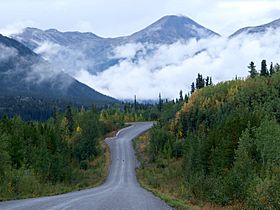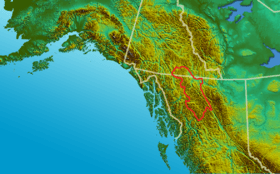Cassiar Mountains facts for kids
Quick facts for kids Cassiar Mountains |
|
|---|---|
| French: Chaîne des Cassiars | |

Cassiar Mountains along Stewart-Cassiar Highway near Good Hope Lake
|
|
| Highest point | |
| Peak | Thudaka Peak (British Columbia) |
| Elevation | 2,748 m (9,016 ft) |
| Geography | |
| Country | Canada |
| Range coordinates | 60°15′N 131°10′W / 60.250°N 131.167°W |
| Parent range | Interior Mountains |
The Cassiar Mountains (French: Chaîne des Cassiars) are the most northerly group of the Northern Interior Mountains in the Canadian province of British Columbia and also extend slightly into the southernmost Yukon Territory. They lie north and west of the Omineca Mountains, west of the northernmost Rockies and the Rocky Mountain Trench, north of the Hazelton Mountains and east of the Boundary Ranges. They form a section of the Continental Divide, that, in this region, separates water drainage between the Arctic and Pacific Oceans. Physiographically, they are a section of the larger Yukon-Tanana Uplands province, which in turn are part of the larger Intermontane Plateaus physiographic division.
In the western Cassiar Mountains lie the remnants of a prehistoric shield volcano called the Maitland Volcano which formed between 5 and 4 million years ago during the Pliocene period.
The highest mountain in the Cassiar Mountains is Thudaka Peak, at 2,748 m (9,016 ft).
Sub-ranges and major summits
- Dease Plateau
- Horseranch Range
- Kechika Ranges
- Sifton Ranges
- Cormier Range
- Ruby Range
- Stikine Ranges
- Beady Range
- Nisutlin Plateau
- Skree Range
- Three Sisters Range
- Thudaka Range
- Tuya Range
See also
 In Spanish: Montañas Cassiar para niños
In Spanish: Montañas Cassiar para niños


